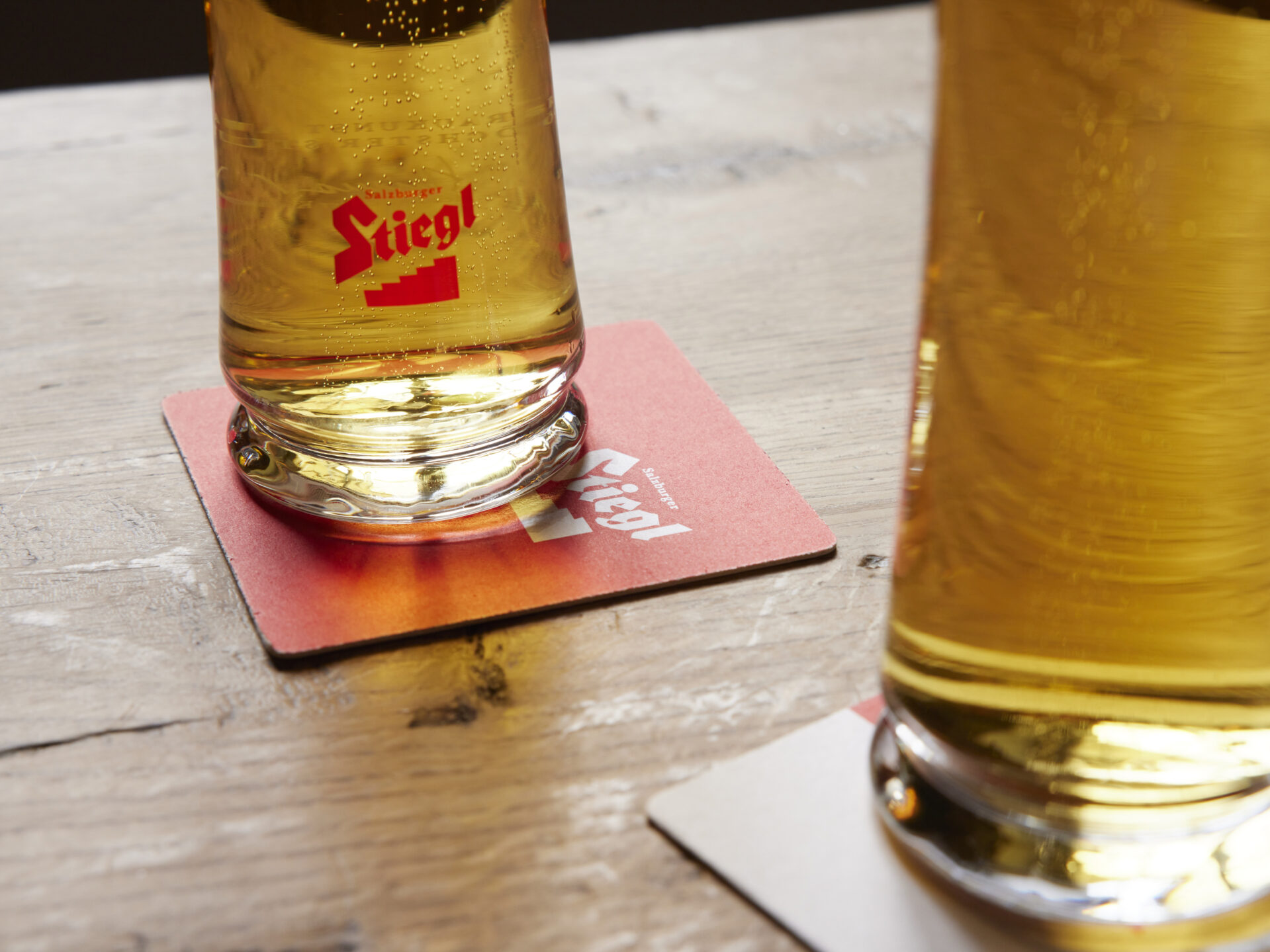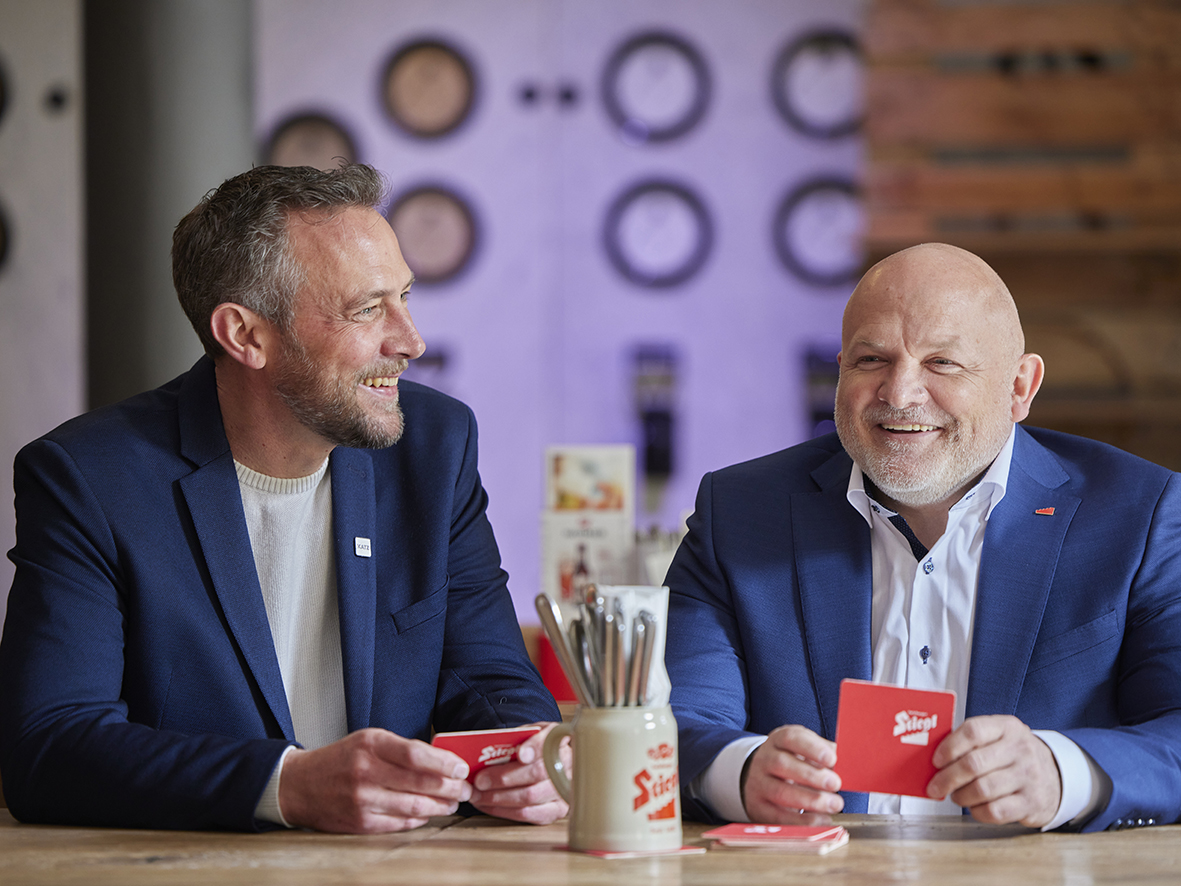
Newsletter #3 | All around the product
“After the glass you drink from, beverage coasters are the most important advertising tool we have in the hospitality industry”
Together with his team, Stiegl Head of Purchasing Thomas Reuter is responsible for everything that Austria’s biggest privately owned brewery buys, including advertising material. And among that material is one item in particular that you can use to write down your ideas, see how many you can flip at one time, and even use to finally stop that obnoxious table from wobbling around: beverage coasters made of wood pulp board. Needless to say, these handy little objects can do way more than just protect the surface of furniture from water damage. In fact, one specific job that these round or square coasters do like no other is that of a brand ambassador.
“Coasters have a direct line to your emotions,” Thomas Reuter confidently says. “People use them to play and to write messages on them – sometimes they even take them home as a souvenir. In other words, they create a connection between our brand and memories of a great night spent somewhere.” Reuter is convinced that there are few things that will bring you closer to consumers than coasters and glassware. Not to mention, of course, that beverage coasters are also super valuable for hosts thanks to their practical uses. There is a reason why Stiegl provides these advertising tools for free and beer truck drivers always have them along for the ride. “People don’t have to order coasters from us. We simply give them out for free to our customers so that the hospitality industry doesn’t run out.”
An emotional return on investment
Reuter will be the first to tell you that trying to attach a monetary value to the benefits of coasters is a fool’s errand at best. Instead, the return on investment is emotional above all: “To put it simply, coasters are there whenever people have great experiences.” In fact, this is why Reuter thinks it is important for the supplier that makes Stiegl’s coasters to really understand the brewery’s clientele.
“We really need for our supplier to be an integral part of the whole process. They need to know the ins and outs of what we do and how we want to convey our brand to others.” Of course, one should not forget that a coaster’s main purpose is to absorb moisture, meaning that coasters should not have too much color printed on them. “Once you really think about it, you discover that coming up with just the right design for a coaster is an art in itself,” Reuter says.
For many years now, Stiegl has relied on KATZ as its business partner when it comes to beverage coasters. This is where Olaf Müller and his history of 16 years as KATZ’s sales manager for customers in Germany, Austria, and Switzerland and as the contact for this business relationship come in: “Olaf knows what makes us tick,” Thomas Reuter says without a hint of doubt in his voice. “And that’s crucial. It’s what makes it possible for KATZ to contribute suggestions and ideas and play an essential part in the way we keep building and redefining our brand.” This takes us to Stiegl’s latest coaster: A square with rounded corners and a striking design that relies solely on red and white colors. “It’s a bit bigger than your standard coaster,” Müller explains, “and the corners are actually less rounded than usual.” This not only makes the whole thing more elegant by doing away with any hint of pretentiousness, but also increases the physical space that the Stiegl brand takes up on tables and bars.
It should perhaps come as no surprise that KATZ and Stiegl are also constantly working on introducing new products rather than limiting themselves to standard coasters. For instance, there is the round hot-foil-embossed coaster made of thicker material that is used for Stiegl’s Columbus 1492 craft beer, leaving a powerful impression that is hard to forget. Or the water-drop-shaped coaster for the spring water served to visitors at Stiegl-Gut Wildshut.
As long as there’s foam
Needless to say, the two long-time business partners are already looking forward to a bright future and many more projects together. “The new needs and preferences of Gen Z are definitely going to leave their mark on our beverage coasters too,” Reuter confidently says. “Who knows? Maybe coasters will get an AI to tell you all about the Stiegl brand through your cell phone in the future.” But the notion that beverage coasters themselves could somehow disappear from the hospitality industry is something that he is quick to dismiss: “As long as there’s foam, as long as the beer’s cold, and as long as the laws of nature keep making water condense on the outside of glassware, we’re going to have beverage coasters.”


